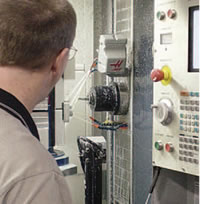
In the first installment of Tech Notes, we identified the three types of coolants available today; emulsified (soluble) oils, semi-synthetics and synthetics. Each coolant has its own strengths and weaknesses, but proper formulation combined with a sound management program will allow most coolants can run effectively.
All coolant formulas include components for improved machining, foam control, biological control, pH stability and corrosion control. In order to manage coolants, understanding the various additives is important, as they are often expended at different rates.
This process is called selective depletion. One of the most common examples of selective depletion can be seen with corrosion prevention additives. In cast iron applications, corrosion prevention additives are exhausted at a much higher rate than in Steel alloy applications.
Record Keeping - Once you have committed to taking control of your coolants, it is important to keep a close eye on the sumps. Recording basic information such as the date the sump is charged as well as the amount and type of additives that were incorporated over time, will give your coolant supplier the basic information they need to work with.
Concentration Control - Once you have established your record keeping practices, you can begin to address your coolant concentration. If you can’t do anything else, basic control of coolant concentration can eliminate most coolant-related problems. A suggested concentration level can be obtained from your coolant supplier.
To track the concentration of your coolant, the refractometer is undoubtedly the best instrument to use. To determine the concentration of your coolant, place several drops of coolant on the refractometer. Looking in the refractometer you will see a scale (usually 1 – 10), and a line will appear between the light and dark areas.
By reading the scale at the line, the refractometer will give you a number. Next, refer to the refractive index, located on your coolant data sheet. The index is multiplied times the reading on your refractometer, giving you the concentration of the coolant (as a percent).
Once you know your coolant concentration, record your readings. You can now adjust the amount of supplemental coolant needed with greater precision than before. As a basic rule of thumb, anytime water is added, some coolant should be added as well.
The easiest way is to control concentration is to use a coolant dispenser. A coolant dispenser is attached to a water hose that is set to deliver the desired concentration. The simplest dispensers are venturi types that use an insert to change concentrations (cost $50-$200). If you can, spend the extra money and buy a dispenser with external knob controls for setting the desired concentration (cost $230-$400).
When filling the sump, use the refractometer to set the coolant to the recommended concentration. Set your refractometer to about half the recommended starting concentration. This is a precautionary approach that will prevent you from adding too much coolant to replace water that has already evaporated.
It is important to note that the outflow side of the dispenser only needs a short hose (max 10 feet) to fill the container or sump. Also, the concentration of the coolant injected into the water stream often varies with the water pressure.
If you have a large sump and want to use an automatic fill dispenser, a positive displacement pump should be used. These dispensers typically cost around $1000, but provide years of accurate control. Once you are controlling your concentration and keeping records of your readings, you now have established a solid foundation for coolant management that will undoubtedly provide immediate returns.
|
ETNA Products 16824 Park Circle Drive, Chagrin Falls, Ohio 44023 Phone: 800-229-3862 / 440-543-9845 Fax: 440-543-1789 Copyright ©2025 ETNA Products, Inc. KOOLRite and SynMAX are trademarks of ETNA Products, Inc. |